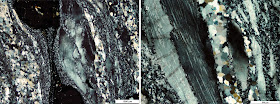Recrystallization
is a common process accompanying formation of the majority of igneous rocks. Evidences proving that a rock crystallized from
true melt or hydrothermal fluid are usually ambiguous and perplexing. Most commonly
these processes are overlapped in space and time causing even more confusion.
Hydrothermal fluids tend to recrystallize rocks they derived from, changing its mineral composition and texture. However some alteration processes result in distinctly zoned patterns consisted of unaltered
host rock (interior), a zone of complete recrystallization and intermediate
zones. Analogue modeling approach was used to study process of crystallization
from melt and subsequent recrystallization caused by emergence of solution. The
experiment involves highly soluble and low melting point materials consisting of ammonium chloride, ammonium thiocyanate and ammonium thiocyanate cobaltate. The experiment resulted in textural metamorphoses (picture above) of the material resembling relations between granites and related to them zoned pegmatites.
Experimental
Oversaturated aqueous solution bearing NH4+, Cl-,
(SCN)-, and [Co(SCN)4]2-(?) ions was prepared by mixing ammonium thiocyante (NH4SCN) and cobalt chloride hexahydrate (CoCl·6H2O) as described
in (Means and Park, 1994). A drop of the solution was placed on a glass slide
and heated up to 80°C. After dehydration the resulted solid residue
was melted at 150°C. The slide with a drop of melt on it was covered with another
slide. Subsequent rapid crystallization yields fine-grained aggregate
consisting of crystals of ammonium chloride (NH4Cl), ammonium
thiocyanate (NH4SCN) and ammonium tetrathiocyanate cobaltate (NH4)2[Co(SCN)4]·nH2O
(Fig.1). Some amount water was
introduced between the two slides after the melt had completely crystallized. Since
the compound is highly soluble, dissolution happens instantaneously, however different
kinds of crystals are dissolving at different rates. The sample was held at
~70°C for at least 15 hours. Dissolution is happening until the solution
reached oversaturation point and crystals started to form. Besides numerous
experiments conducted as described above some of the samples were deformed (via
pressing the slide) to cause fracturing and thus, to produce more extensive
recrystallization. All of the outcomes of the experiment were studied under a
petrographic microscope.
Results
During
rapid crystallization of the melt ammonium
chloride crystallized first forming fine colorless cubic crystals. Ammonium
thiocyanate forms after (or simultaneously) ammonium chloride had formed, demostrating colorless crystals with acicularhabit, frequently skeletal aggregates. Ammonium tetrathiocyanate cobaltate forms fine blue crystals in the
interstitial space between the solidified phases; individual grains are
indistinguishable (Fig. 1, Video 1).
After introduction of water the compounds
start to dissolve quickly but at different rates. Acicular crystals of
ammonium thiocyanate disappear instantaneously, whereas ammonium chloride
crystals remain undissolved. Ammonium
thiocyanate cobaltate remains in the solution for some time but
also forms a narrow line at the front of crystallization (Fig. 2, Video 2).
Textural transformation occurred after
a sample was heated up to ~70°C and remained at this temperature for 15h. It resulted in form of three distinct zones: the outermost zone with coarse-grained
texture (front); the intermediate zone with “blocky” texture (the term was
firstly applied by Means and Park, 1994); zone with the original “igneous” textures
– the interior, that underwent slight changes (Fig. 3, bottom picture - quenched textures are still observed). All three zones are
composed of the same three minerals which were described before. Frequently,
the interior undergoes slight coarsening due to presence of moisture in the air
and the neighboring zones (Fig. 3, top picture).
Figure 1. Sample
of rapidly crystallized melt: 1 - NH4SCN ammonium thiocyanate,
monoclinic symmetry, colorless in plane polarized light (PPL), oblique extinction;
2 - (NH4)2[Co(SCN)4]•nH2O ammonium
tetrathiocyanate cobaltate, orthorhombic (?) symmetry, blue in PPL, straight
extinction; 3 - NH4Cl
ammonium chloride (”sal ammoniac”), cubic sym., colorless, isotropic in
crossed polarized light (XPL).
In deformed samples
recrystallization involved bigger volume of the material compared to the
experiments carried out without deformation. Recrystallization occurred not
only at the front but also along microscopic fractures (Fig. 4a) and wide open
cracks. "Mineralogical" composition of fracture filling material differs from
place to place. The open wide cracks are filled with ammonium thiocyanade and ammonium
thiocyanade cobaltate (Fig. 4b). The very fine fractures were healed with
ammonium tetrathiocyanate with some voids remained unfilled. Submicroscopic fractures are healed by ammonium tetrathiocyanate cobaltate
(Fig. 4c).
Figure
2. Initial stage of dissolution. NH4SCN (colorless, acicular) turns
into solution instantly, whereas NH4Cl (cubic, colorless) and (NH4)2[Co(SCN)4]•nH2O
(blue) are still dissolving. Note a narrow blue line forming along the front of
dissociation.
Discussion
Coarse
crystals at the front appear to be formed from the least saturated solution
which was the very last portion of liquid present in the sample (Fig. 3). Sparse nucleation of slowly growing crystals happened on the outermost boundary of the intermediate zone. In the intermediate zone crystals precipitated from the most saturated solution existed in the sample. Nucleation occurred densely. Composition of the interior does not change, however the aggregate becomes slightly coarser grained retaining its main patterns (Fig. 4c).
which was the very last portion of liquid present in the sample (Fig. 3). Sparse nucleation of slowly growing crystals happened on the outermost boundary of the intermediate zone. In the intermediate zone crystals precipitated from the most saturated solution existed in the sample. Nucleation occurred densely. Composition of the interior does not change, however the aggregate becomes slightly coarser grained retaining its main patterns (Fig. 4c).
Figure
3. Product of recrystallization (after 70°C
for 24h). 1 – front of recrystalliztion, 2 - intermediate zone
with “blocky” texture, 3- interior.














